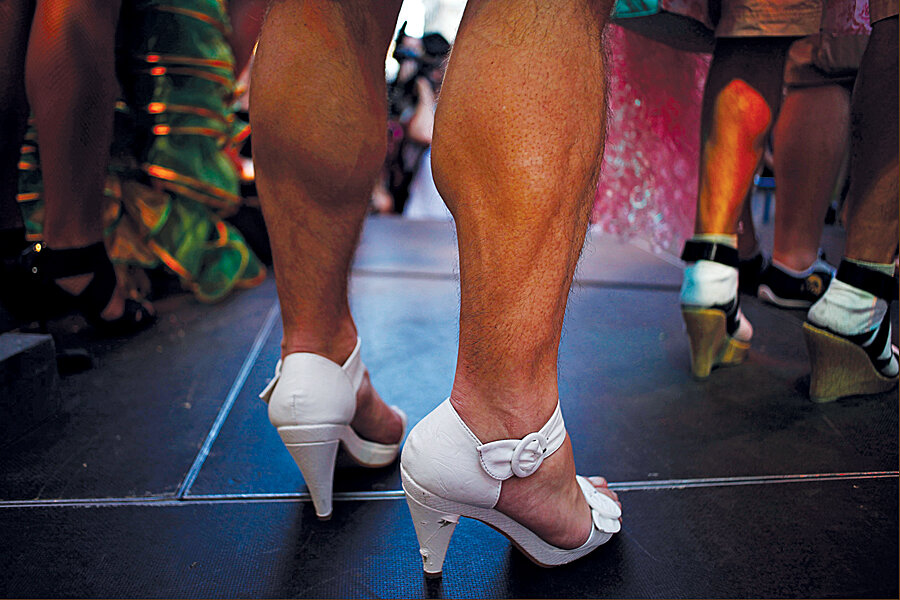Good Reads: Women in crime, democracy's era, digital mapping, a history in heels
Loading...
War is ambiguous. Sometimes it’s easy to tell the good guys from the bad guys. But more often, players fall somewhere in between, both committing crimes and being deeply affected by them. The drug war in Mexico is no different, no matter if the participants are men – or women.
Julie Turkewitz in The Atlantic Monthly interviews Katie Orlinsky about her project photographing female prisoners in Ciudad Juárez, Mexico, bringing a fresh eye to the conflict there.
Turns out, writes Ms. Turkewitz “women – not just men – were serving as its weary warriors, ferrying contraband and kidnapping kingpins. Between 2007 and 2011, the number of women incarcerated for federal crimes rose 400 percent.”
It was a figure that Ms. Orlinsky wanted to understand. Were these women – mothers, sisters, teachers, and widows – victims or perpetrators? The answer, of course, both provides insight into the drug war and highlights how complex of an issue it is.
“ ‘I am not ashamed. There are worse things,’ says Lorena, who is in prison for drug trafficking. ‘My husband is dead and I did it for my children.’ ”
Democracy in demand
Contrary to popular thought, the world is ready for democracy. Arguments that poor, non-Western countries are in some way not “ready” for democracy have been upended, writes Larry Diamond in The Wilson Quarterly.
Two mainstream theories on democracy have directed the discussion for decades: One postulated that countries had to grow rich under authoritarian rule before they would be able to sustain democracy. The other insisted that some countries were poor “because the West had trapped them in a structural condition of economic dependence and servitude (a modern form of imperialism),” writes Mr. Diamond.
But something funny happened in the 1980s and ’90s: A number of poor countries went ahead and adopted forms of democratic government, and for well over a decade, many of them have had some success. Consider Taiwan and South Korea: “Once they achieved democracy, South Korea and Taiwan continued to record brisk economic growth,” writes Diamond.
Although countries and regions vary widely, and many do not trust politicians, polls say people prefer democracy to authoritarianism. “This is strikingly the case now in the Arab world, where the Arab Barometer surveys show that upward of 80 percent of the citizens of most countries name democracy as the best form of government, even if they do not define democracy in fully liberal and secular terms.”
It’s not a perfect road, of course, because systems of corruption easily undermine democratic progress. But the best way to democracy may be just to trudge through it.
In iPhone we trust
Remember when driving to someplace new meant consulting a foldout map before you left the house? Those days are more or less gone with the advent of GPS, smart phones, and digital mapping.
Mapping the indoors could be the next frontier. Just think: You’re in Home Depot or Ikea and with a touch to your smart phone you can orient yourself, find what you are looking for, avoid congested aisles, and compare prices. But does this convenience mean we will stop thinking for ourselves?
Kat Austen in The New Scientist warns of the perils of overdependency on digital mapping. “Apple recently misplaced an Australian town on its iPhone map, a mistake which led to the map’s users becoming lost in the outback and having to be rescued by police.”
And if your battery runs out, there’s no app for that.
Men in heels
High heels were designed for men, not women. That’s right. Another surprising news flash: They weren’t designed for walking.
“The high heel was worn for centuries throughout the near east as a form of riding footwear” for men, Elizabeth Semmelhack of the Bata Shoe Museum in Toronto tells William Kremer for the BBC.
Persia, with the largest cavalry in the world, was the epitome of masculinity. The shah wanted to ally with rulers in Western Europe to defeat the Ottoman Empire so he sent diplomats to Russia, Germany, and Spain. The exotic warriors wore ornate outfits and heeled boots, which helped them stay on their horse while shooting arrows.
When all things Persia (modern-day Iran) became the rage in 16th-century Europe, “Persian style shoes were enthusiastically adopted by aristocrats, who sought to give their appearance a virile, masculine edge that, it suddenly seemed, only heeled shoes could supply,” writes Mr. Kremer.
It didn’t matter that they were completely impractical for the muddy, rutted streets of Europe. And in the following century European women adopted the trend. Men’s fashion, meanwhile, took a turn toward the more practical, dropping them completely by 1740 as “foolish.” Some 50 years later women followed, leaving the world more or less sans heel until the mid-19th century when female fashion tottered over the sidewalk once more.








